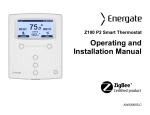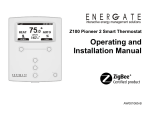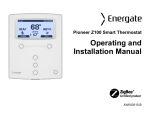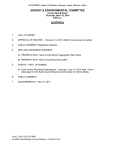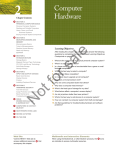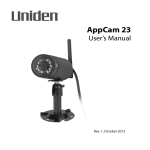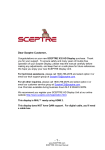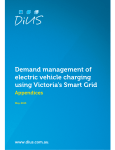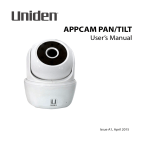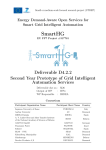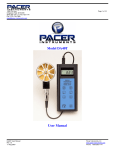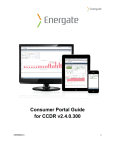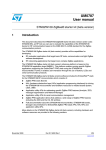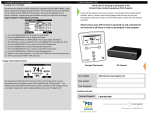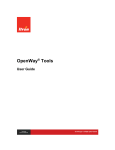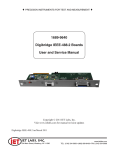Download Pioneer 2.2 Z100 P2 Smart Thermostat User Manual
Transcript
Z100 Pioneer 2 Smart Thermostat Operating and Installation Manual AW000655-E Page 2 Operating and Installation Manual Congratulations on the purchase of your new thermostat. It has been designed for easy programming to save on energy costs and allow a comfortable living environment. Features: Auto programming mode for your yearly heating and cooling needs Easy adjustment of temperature and schedule Energy efficient presets to help reduce heating and cooling costs Wirelessly communicates with your utility Notifies you and automatically responds to utility demand response events Provides you with the current price of energy or rate tier Lets you select from a range of comfort and savings levels when energy prices increase Large, easy to read backlit display Silent operation Protection against short circuits during installation Page 3 Table of Contents OPERATING THE THERMOSTAT ............................................................................................. 7 Navigating the Controls .............................................................................................................. 7 Home Screen ............................................................................................................................. 8 Heat / Cool / Fan Icons ......................................................................................................... 10 Setpoint Value Display .......................................................................................................... 10 HELP button ............................................................................................................................. 11 Title Bar.................................................................................................................................... 11 Default Schedule ...................................................................................................................... 12 Temporary Temperature Hold ................................................................................................... 14 Heating and Cooling Modes ...................................................................................................... 16 Fan Modes ............................................................................................................................... 16 Main Menu ............................................................................................................................... 17 Temperature Settings ............................................................................................................... 18 Quick Schedule ........................................................................................................................ 18 Advanced Schedule.................................................................................................................. 19 Schedule Type ...................................................................................................................... 20 Setpoints .............................................................................................................................. 21 Schedule .............................................................................................................................. 22 Hold Screen - Permanent, Timed, and Temporary Temperature Holds...................................... 23 Setting the Date & Time............................................................................................................ 26 Energy Events and Price Events ............................................................................................... 28 Page 4 Energy Events (also known as DRE / DRLC events) ................................................................. 28 Voluntary and Mandatory Energy Events............................................................................... 29 Starting a Temporary Temperature Hold during an Energy Event .......................................... 30 Energy Options Screen............................................................................................................. 31 Price Conservation Event ......................................................................................................... 31 Conservation Screen ................................................................................................................ 33 Indicators of Energy Events and Savings .................................................................................. 35 Utility Text Messages................................................................................................................ 36 User Options ............................................................................................................................ 37 Price Display Options ............................................................................................................ 37 Filter Reminder ..................................................................................................................... 38 Time ..................................................................................................................................... 38 Temperature Units and Calibration ........................................................................................ 39 Languages ............................................................................................................................ 39 Service Information ............................................................................................................... 40 Power Outages......................................................................................................................... 40 INSTALLATION AND MAINTENANCE .................................................................................... 41 Mounting the Thermostat .......................................................................................................... 41 Mounting the Thermostat (continued) ........................................................................................ 42 Mounting the Thermostat (continued) ........................................................................................ 43 Mounting the Outdoor Sensor ................................................................................................... 44 Cleaning the Thermostat........................................................................................................... 44 Removing Thermostat Front Housing from Backplate ............................................................... 45 Page 5 Replacing the Battery ............................................................................................................... 46 Wiring Configuration ................................................................................................................. 47 Setup Menu Options ................................................................................................................. 48 Password .............................................................................................................................. 48 Setpoint Range ..................................................................................................................... 49 Equipment Type.................................................................................................................... 49 Equipment Settings ............................................................................................................... 50 Conventional Systems ....................................................................................................... 50 Heat Pump Systems.......................................................................................................... 51 Control Options ..................................................................................................................... 52 Device Info Screen................................................................................................................ 53 ZigBee Link Info Screen ........................................................................................................ 55 Reset Screen ........................................................................................................................ 57 Thermostat Reset.............................................................................................................. 58 User Configuration Reset .................................................................................................. 60 Security Keys Reset .......................................................................................................... 60 Conventional System Test ........................................................................................................ 61 Heat-Pump System Test ........................................................................................................... 62 Product Conformity ................................................................................................................... 63 Caution..................................................................................................................................... 63 Note: ........................................................................................................................................ 64 Page 6 OPERATING THE THERMOSTAT Navigating the Controls The function of the LEFT and RIGHT TAB buttons appears on the bottom of the display screen. Use the SCROLL (▲ ▼) buttons to adjust the temperature, move through the menus options, and change highlighted values. Press the MENU / SELECT (√) button to access the menu as well as to select or accept highlighted menu items. Page 7 Home Screen The Home screen displays current temperature and operation data. When the Home screen is in Idle mode, the backlight is on with low brightness. Please note that icons such as heat or fan are animated when the equipment is running. Note: A SETPOINT (e.g., LEAVE) is identified by a name and specifies both heating and cooling target temperatures. See the Temperature Settings section for additional information. Page 8 By just pressing any of the buttons, the Home screen becomes Active, the backlight brightens and the MODE and FAN tabs are shown. Pressing the LEFT TAB button changes the thermostat mode (COOL/HEAT/AUTO/EMERG/OFF). The available options for the thermostat mode will depend on the type of heating or cooling equipment at your home. Pressing the RIGHT TAB button changes the fan mode (ON/AUTO) Pressing the SCROLL (▲ ▼) buttons makes the temperatures of the SETPOINTs higher (warmer) or lower (cooler). You can accept the changes by pressing the LEFT TAB, which will be displaying ACCEPT, or you can walk away after making the changes. They will be automatically accepted when the screen goes to the Idle mode (i.e. the backlight diminishes to low). To see the different menu items displayed, the MENU / SELECT (√) button needs to be pressed once when the screen is active or twice when it is in the Idle mode. Page 9 Heat / Cool / Fan Icons Icon Description Heating mode (animated when furnace or heat pump is on). Cooling mode (animated when air conditioning or heat pump is on). Auxiliary heating on (animated). More than one heating stage on (animated). More than one cooling stage on (animated). Fan (animated when on). Setpoint Value Display The thermostat is controlling the HVAC equipment to keep the home at the displayed setpoint temperature, and will heat or cool accordingly. The thermostat is anticipating the next scheduled SETPOINT temperature, which is higher than the displayed value, and turning on heating. The thermostat is anticipating the next scheduled SETPOINT temperature, which is lower than the displayed value, and turning on cooling. Page 10 HELP button The thermostat’s HELP ? button provides you with information on how to navigate through the individual menu screens. It will help you to quickly change settings without having to refer to this user manual; however, it does not replace this manual, so please keep this manual for future reference. Title Bar The left hand side of the Title Bar displays an icon showing the state of the communications link with the utility’s network (signal quality). means Link OFF, highest signal quality (5 bars). means Link ON, and varies from lowest signal quality (1 bar) to When the communications link is on, the network automatically updates the date and time in your thermostat periodically. If the communications link is off, you need to set the current date and time as explained in Setting the Date & Time section (page 26) The Title Bar also displays the current electricity rate if your utility company provides energy price information over the communication link. The price is displayed either in $ value/KWH (default) or by the price tier name. This is assigned by your utility to different rates (e.g. normal, low, medium, high, critical peak). By pressing the MENU / SELECT button and selecting the USER OPTIONS menu item in the MAIN MENU, and then selecting PRICE DISPLAY, you can choose which of the two ways the current price is displayed. Page 11 Default Schedule The thermostat’s schedule is factory programmed with Energy Efficient START TIMES and SETPOINTS (listed below). Note: A SETPOINT has a pre-set name and specifies both heating and cooling target temperatures, as explained in detail in the Temperature Settings section. This default schedule may be modified as desired to meet your comfort and schedule requirements. The thermostat anticipates the time required to reach a desired temperature prior to the start of the SETPOINT time; therefore, you only need to set the desired time for the SETPOINT temperature. SCHEDULE – Fahrenheit Scale Monday to Friday START TIMES Saturday & Sunday SETPOINT NAME HEAT COOL 6:00 am Wake 70.0°F 78.0°F 8:00 am Leave 62.0°F 85.0°F 6:00 pm Return 70.0°F 78.0°F 62.0°F 82.0°F START TIMES NAME HEAT COOL Wake 70.0°F 78.0°F 11:00 pm Sleep 62.0°F 82.0°F 8:00 am 10:00 pm Sleep Page 12 SETPOINT Default Schedule (continued) SCHEDULE – Celsius Scale Monday to Friday START TIMES Saturday & Sunday SETPOINT NAME HEAT COOL 6:00 am Wake 21.1°C 25.6°C 8:00 am Leave 16.7°C 29.4°C 6:00 pm Return 21.1°C 25.6°C 16.7°C 27.8°C 10:00 pm Sleep START TIMES SETPOINT NAME HEAT COOL 8:00 am Wake 21.1°C 25.6°C 11:00 pm Sleep 16.7°C 27.8°C Page 13 Temporary Temperature Hold A Temporary Temperature Hold allows you to temporarily make the temperature warmer or cooler without affecting the pre-set programming. The thermostat will remain at the Temporary Hold temperature until the next scheduled SETPOINT. From the Home screen, press either of the SCROLL buttons to adjust either the HEAT (if the current operating mode is HEAT) or the COOL (if the current operating mode is COOL) of the active target SETPOINT, shown below the room temperature, with two arrows beside it. To accept the adjusted SETPOINT press the LEFT TAB .To cancel, press the RIGHT TAB. Note that even if you don’t press the ACCEPT tab, the Temporary Hold will take effect when the screen goes on idle (i.e. the screen backlight diminishes to low). When the thermostat mode setting is AUTO, pressing the MENU / SELECT button will switch between the HEAT and COOL SETPOINTS (i.e. the screen will show “ADJUST HEAT” or “ADJUST COOL” respectively). The LEFT TAB accepts the Temporary Hold settings and the RIGHT TAB cancels them. Page 14 Temporary Temperature Hold (continued) Once the Temporary Hold is in effect, the SETPOINT name will be replaced by TEMPORARY. Note that a Temporary Hold can also be set by scrolling to the HOLD menu item at the Main Menu and selecting TEMPORARY as the Type of Hold, as it is explained further in the section describing the HOLD screen. To CANCEL a Temporary Hold, press any of the SCROLL buttons to return to this screen. Press the RIGHT TAB to cancel the HOLD, or LEFT TAB to accept it (continue the hold) and return to the normal Home screen. Page 15 Heating and Cooling Modes The thermostat is pre-set for heating operation (HEAT) but, as explained when describing the HOME SCREEN, you can manually (by pressing the LEFT TAB) change the thermostat mode between AUTO, HEAT, COOL, OFF, and EMERG. The available options for the thermostat mode will depend on the type of heating or cooling equipment at your home. AUTO: HEAT: COOL: OFF: EMERG: The thermostat automatically selects heating or cooling based on the indoor temperature. The thermostat controls only the heating system. The thermostat controls only the cooling system. Heating and cooling systems are off. This setting only applies to heat pumps with auxiliary heat. The thermostat only controls the Emergency (Auxiliary) heat, leaving the heat pump’s compressor locked out. Use this setting only when you suspect the heat pump is out of service or the outdoor conditions may lead to an inefficient operation of the heat pump. Fan Modes You can manually change the fan mode between AUTO and ON, by pressing the RIGHT TAB. AUTO: ON: Page 16 The fan runs only when the heating, cooling, or emergency systems are on. As described in detail in the Installation section of this manual, for conventional systems, under EQUIPMENT SETTINGS, with FAN ON IN HEAT set to NO, the fan is not controlled by the thermostat, but by the furnace. The fan runs continuously. Main Menu From the Home Screen, pressing the MENU / SELECT button once (if the screen is active) or twice (if it is in the idle mode), the MAIN MENU appears as it is shown on the left. Using the SCROLL buttons, you can scroll to the desired menu item, as shown in the two screen shots on the left. Press the MENU / SELECT button to select the desired menu item. Page 17 Temperature Settings A SETPOINT is identified by a NAME and specifies heating and cooling target temperatures. Example: If the SETPOINT is set to WAKE, with COOL temperature of 78°F and HEAT temperature of 70°F, a thermostat operating in AUTO mode will keep your dwelling’s temperature at the predefined HEAT or COOL temperature. In the summer, the thermostat will COOL your dwelling down to 78°F. In the fall, the thermostat will engage the HEAT mode, heating your dwelling up to 70°F throughout the winter. In the spring, when temperatures rise again, the thermostat will change back to COOL mode. The SETPOINTs HEAT and COOL temperatures can be changed either from the Quick Schedule screen or from the menu item SETPOINTS selected from the ADVANCED SCHEDULE menu, as explained below. Quick Schedule The QUICK SCHEDULE screen allows you to quickly modify the temperatures and starting times of the SETPOINTS. You can get into this screen from the Main Menu. Use the MENU / SELECT button to select the starting time or HEAT or COOL temperature that you wish to change, and use the SCROLL buttons to obtain the desired value. Press the LEFT TAB that will show SAVE CHANGES and then continue with the NEXT DAY (shown now on the LEFT TAB). Page 18 Advanced Schedule The Advanced Schedule menu is reached by selecting the menu item ADV. SCHEDULE on the Main Menu By pressing the MENU / SELECT button, takes you to the ADVANCED SCHEDULE menu, where you can choose one of three menu items: SCHEDULE TYPE, SETPOINTS and SCHEDULE. Page 19 Schedule Type The SCHEDULE TYPE screen allows you to choose among three different weekly schedule types. These are: 5/2 DAYS 7 DAYS 5/1/1 DAYS Monday – Friday schedules are the same. Saturday & Sunday schedules are the same Every day of the week has an individual schedule. Monday – Friday schedule is the same. Saturday has an individual schedule, and Sunday has an individual schedule. By pressing the MENU / SELECT button, while in the ADV. SCHEDULE menu you get access to the Schedule Type screen. Use the SCROLL buttons to change the weekly schedule type. Press the LEFT TAB to SAVE CHANGES. Page 20 Setpoints The SETPOINTS screen shows on the left the list of names of the different SETPOINTS programmed in your thermostat and on the right the corresponding heating (in winter) and cooling (in summer) target temperatures. To change the HEAT and COOL temperature settings, SCROLL to the SETPOINT you want to change and press the MENU / SELECT button. SCROLL to change the temperature, or press again the MENU / SELECT button to move between the HEAT and COOL settings. As soon as you start changing a temperature, the LEFT TAB will show SAVE CHANGES. Press this TAB if you want to save them or cancel them by pressing the RIGHT TAB (CANCEL). You can also modify the name of the SETPOINTS, by scrolling to the SETPOINT you want to change and pressing EDIT NAME. You can change one letter at a time by SCROLLING through the alphabet until you get to the desired letter, then pressing MENU / SELECT to move to the next letter of the name. Once done, press SAVE CHANGES. Page 21 Schedule The SCHEDULE determines when a SETPOINT such as WAKE begins. Only the start times are defined; the SETPOINT ends at the start of the next SETPOINT. From the ADVANCED SCHEDULE menu, choose the menu item SCHEDULE and press the MENU / SELECT button to view the SCHEDULE screen. The PROGRAM window displays the SETPOINT associated with the start time on the right. Adjust the start time by pressing the MENU / SELECT button and SCROLLING through the time. Press SAVE CHANGES. Press the MENU / SELECT button to move inside the PROGRAM window. Here the SETPOINT can be SCROLLED to choose the name of a different SETPOINT. Press the MENU / SELECT button again to return to the start times on the right. Once you finished programming the schedule for a day, press NEXT DAY to continue with the following day. To delete a start time, SCROLL to the start time, press the MENU / SELECT button and the selected start time will be underlined. Press again the MENU / SELECT button, which will cause the corresponding SETPOINT to be underlined too. Press any of the SCROLL buttons until the screen shows a blank SETPOINT. This deletes the start time. To add a new start time (you can have up to 6 scheduled start times), SCROLL to a blank row, SELECT it, and SCROLL to an appropriate SETPOINT. Press MENU / SELECT to select it and to go back to the start times. Change the start time to the desired one and then press SAVE CHANGES. Page 22 Hold Screen - Permanent, Timed, and Temporary Temperature Holds The SCHEDULE can be overridden to maintain a desired SETPOINT through either a: Permanent Temperature Hold (hold until cancelled) Timed Temperature Hold Temporary Temperature Hold (hold until the next scheduled SETPOINT) Choose HOLD from the Main Menu. Once in the HOLD screen, use the SCROLL buttons to choose the HOLD Type. Permanent Hold To choose a Permanent Hold, use the SCROLL buttons in the HOLD screen until you see PERMANENT underlined next to TYPE. If you want to change the HEAT and/or COOL temperatures, you can do so by pressing the MENU / SELECT key and then the SCROLL buttons to increase or decrease the temperatures. You can also change the SETPOINT name from HOLD to another one, by pressing again the MENU/SELECT key and then scrolling though the different SETPOINT names. The Heat and Cool temperatures will change accordingly. (Only the HOLD SETPOINT allows the temperatures to be independently set). Press SAVE CHANGES to accept the new settings and initiate the Hold. To cancel the Hold, return to the HOLD screen and press the CANCEL HOLD tab. Page 23 Hold Screen - Permanent, Timed, and Temporary Holds (continued) Timed Hold Once you choose the TIMED hold, you can change the date and time until it will be effective, by pressing the MENU/SELECT button. The date and/or time will be respectively underlined and you will be able to change them by using the SCROLL buttons. As in the case of the Permanent Hold, you can change the HEAT and/or COOL temperatures by pressing the MENU / SELECT key and then the SCROLL buttons to increase or decrease the temperatures. You can also change the SETPOINT name from HOLD to another one, by pressing again the MENU/SELECT key and then scrolling though the different SETPOINT names. The Heat and Cool temperatures will change accordingly. (Only the HOLD SETPOINT allows the temperatures to be independently set). Press SAVE CHANGES to accept the new settings and initiate the Hold. To cancel the Hold, return to the HOLD screen and press CANCEL HOLD. The type of hold will show: NONE underlined. Page 24 Hold Screen - Permanent, Timed, and Temporary Holds (continued) Temporary Hold The Temporary Hold is set to override the thermostat schedule temporarily, but it will be cancelled by the next scheduled SETPOINT, as explained before in the section called Temporary Hold. Note that the line UNTIL: shows the date and time the Temporary Hold will end, which is the date and time of the next scheduled SETPOINT. You will not be able to change the date and time shown on this screen. Once you choose a Temporary Hold, you can change the HEAT and/or COOL temperatures by pressing the MENU / SELECT key and then the SCROLL buttons to increase or decrease the temperatures. Press SAVE CHANGES to accept the new settings and initiate the Hold. To cancel the Hold, return to the HOLD screen and press CANCEL HOLD. Page 25 Setting the Date & Time When the thermostat’s communication link to the utility’s network is active, the network periodically updates the date and time, so you will be prevented from modifying this setting. If the communications link is inactive (an “X” displayed in the top left corner), you can set the current date and time by selecting the TIME menu item from the USER OPTIONS menu. Using the same menu item, you can also change between a 12H or 24H clock format. Press the MENU / SELECT button to view the MAIN MENU as shown in this screen. Use the SCROLL buttons to scroll to the USER OPTIONS menu item. Press again the MENU / SELECT button. The USER OPTIONS menu will appear as shown at the left. Use the SCROLL down button to scroll to the TIME menu item. Press the MENU / SELECT button to enter the TIME screen. Page 26 Setting the Date & Time (continued) The TIME screen will appear as shown at the left. To change between 12 and 24 hour clock formats, scroll to the CLOCK FORMAT menu item. Press MENU / SELECT. The setting will be underlined. You can change the format using the SCROLL buttons and then pressing SAVE CHANGES to accept the change. To adjust the date and time, use the SCROLL buttons to point to the month, which is underlined, to change it, use the SCROLL buttons, then press the LEFT TAB (SAVE CHANGES). Press MENU / SELECT to move between fields. Use the SCROLL buttons to change the value of the underlined field. Press MENU / SELECT to move between hour and minute adjustment. Press SAVE CHANGES to accept the new settings. To return to the USER OPTIONS menu, press the RIGHT TAB (EXIT). Page 27 Energy Events and Price Events Energy / Price Events occur during specific time intervals when your utility actively reduces consumer electricity consumption, or institutes higher energy prices to discourage consumption. This happens when your utility needs to reduce the load on the electricity grid, and these events are referred to as: Energy Events (also known as Demand Response Events, or Demand Response Load Control Events) Price Conservation Events Energy Events (also known as DRE / DRLC events) During an Energy Event, your utility sends a signal to the thermostat to indicate that the target SETPOINT temperatures should be modified in order to reduce the energy use by your heating and/or air conditioning systems. In the Home screen the SETPOINT name is replaced by the name of the Energy Event, which is ENERGY EVENT by default. For each energy event, your utility will specify when the event will start and end, as well as either a desired temperature, a target temperature offset or duty cycle. Page 28 An offset is the number of degrees above (in COOL mode) or below (in HEAT mode) the current target temperature setting programmed into the thermostat. If the utility selects a desired duty cycle, it will be shown as a percentage of time that your heating and/or air conditioning system operates, rather than the desired temperature. The event can also end if your utility cancels it. Voluntary and Mandatory Energy Events An Energy Event (DRLC event/DRE) can be voluntary or mandatory. In the case of a Voluntary Energy Event you may accept the temperature setback suggested by your utility, or you can either Override the event or Opt-Out of it. The Overriding of a voluntary Energy Event can be done while starting a Temporary Hold after the event has started, as will be explained in the next section. You can also Opt-Out from Voluntary Energy Events permanently by selecting the Energy Options menu from the Main menu and then selecting Opt-Out. If you change your mind, you can Opt-In by selecting Opt-In from the Energy Options menu. Note that once you select to Opt-Out you will be excluded from all future voluntary energy events until you select to Opt-In again. Page 29 Starting a Temporary Temperature Hold during an Energy Event During an Energy Event you can always start a Temporary Hold through the Home Screen, following the procedure explained in the Temporary Hold section. In this case, when you press ACCEPT, a warning message will be displayed advising you that there is an Energy Event in progress, which are the limits specified by the event and when it will end. If the Energy Event is Voluntary, the LEFT TAB will show OVERRIDE, giving you the option of Overriding the event. If the Energy Event is Mandatory, no LEFT TAB will be shown so you don’t have the option of overriding the event. In all the cases, the desired Temporary Hold will be started, but if the event has not been overridden, the limits set by the Energy Event will be applied during the Temporary Hold, meaning that whenever the Temporary Hold specifies a temperature which will result in a higher energy consumption than any of the limits set by the event, the Temporary Hold setpoint will be replaced by that limit. Page 30 Energy Options Screen The Energy Options screen allows you to permanently disable Voluntary Energy Events. Choose ENERGY OPTIONS from the Main Menu to view this screen. The options are: OPT-IN and OPT-OUT. To change from OPT-IN to OPT-OUT, you need to SCROLL to OPT-OUT and press SAVE CHANGES. Price Conservation Event Some utilities have energy (electricity) prices which vary depending on the time of day, and in some cases when demand is approaching its highest levels, a critical peak price is charged. In these situations your utility can send Price Events, which will display the current energy price on your thermostat. If desired, the current energy price can also be used to trigger a Price Conservation Event. When a Price Conservation Event is triggered, the thermostat responds based on which of the five levels you selected from on the Conservation Screen (see Conservation Screen section). Price Conservation Events are always voluntary. You can always start a Temporary Hold during a Price Conservation Event. In this case, the Price Conservation Event will be suspended during the duration of the Temporary Hold. Page 31 You can also permanently OPT-OUT of Price Conservation Events, by setting your thermostat’s Conservation to Maximum Comfort (described in more detail in next section). Note that it is possible to have an Energy Event (DRE/DRLC event) while there is a Price Event happening (e.g. your thermostat can be under a Price Conservation Event when an Energy Event is being sent by your utility). Energy events and price events are different and separate events; utilities may send either, neither, or both kinds of events to the thermostat. You may also participate in (opt-into) or ignore (opt-out of) energy events (if not mandatory) and price conservation events independently – meaning that you can set up your thermostat to save energy and money by acting on either event type, or both, or neither. A temporary temperature hold can be set to opt out of both price conservation and energy (DRLC) events, even when both events are on concurrently. Page 32 Conservation Screen The Conservation feature allows you to choose your desired comfort level (i.e. from maximum comfort and no savings to maximum savings and minimum comfort) when energy prices increase. Please note that not all utilities provide price information over the communications link so this screen may not be activated for your program. To use the Conservation Screen, you need to access the Main Menu and then press the MENU / SELECT button when the cursor is on the COMFORT menu item. This takes you to the Conservation Screen, where you can see the following screens, and choose the level of Comfort you want by pressing the arrow (SCROLL) buttons.: If you choose the Maximum Comfort, as shown at the left, your program settings will not be affected by an increase in price (i.e., you are prepared to pay the increased rates to maintain your desired comfort level by having the thermostat take no action when price is high). By continuing to press the arrow buttons, you can also choose Comfort, as shown here. The thermostat now makes little or no target temperature adjustments when the price goes up by a small amount, but when rates go higher so do the temperature setbacks. This setting favors comfort over savings. Page 33 By choosing the Balanced Level, price increases and temperature adjustments strike a balance between comfort and savings. The Savings Comfort Level places a higher value on savings over comfort such that the temperature adjustments are greater for a given price increase. Maximum Savings means that your thermostat will change the temperature in the direction of maximum energy savings every time there is an increase in the price of energy. Page 34 Indicators of Energy Events and Savings The Thermostat has four Light Emitting Diodes (LEDs) located on the center portion of the case, below the LCD screen. These four LEDs are in order from left to right: BLUE, YELLOW, ORANGE and RED. BLUE YELLOW ORANGE RED This LED will light up when an energy (DRE/DRLC) event or a price conservation event is in progress. As the price of energy increases, one of the YELLOW, ORANGE or RED LEDs will light up. The RED LED is used when the price is very high. Note that you will see one or, a maximum of two lights on at the same time (i.e., BLUE and one of the YELLOW, ORANGE or RED lights). Page 35 Utility Text Messages Your utility may send text messages to your thermostat to provide information. For example, they might inform you of upcoming events. A text message sent from your utility will be displayed when the thermostat is on the home screen. It will remain displayed until you acknowledge the message, until the message expires, or until your utility cancels the message. To view the last message transmitted by your utility, SCROLL down in the main menu to GET LAST MESSAGE. Press MENU / SELECT. Press OK to confirm that you do wish to retrieve the last message or press CANCEL to return to the Home screen. If you confirm that you wish to retrieve the last message, a request will be sent to your utility, which will send the last text message, if applicable. Page 36 User Options The USER OPTIONS menu allows you to set up the configurations of the price display, date and time, temperature and language. It also allows you to remind yourself when you have to change the filter of your equipment and also to save service information that you may need in future. Price Display Options From the Main Menu, SELECT the User Options menu item. You will be directed to the USER OPTIONS menu as shown on the left. The Price Display menu item defines which type of price information will be displayed in the Title Bar on the Home screen when there is a Price Information Event in effect. The options are: COST/KWH and TIER NAME. SCROLL to change between both options. Please note that not all utilities provide price information over the communications link so you may not see the price information displayed in the Title bar. Page 37 Filter Reminder You can program the Filter Reminder by going to the FILTER REMINDER screen from the USER OPTIONS menu. Once in the FILTER REMINDER screen, you can set (in months) when you need to change the filter. It can be set from 0 to 12 months. Setting it to 0 effectively disables the CHANGE FILTER reminder. After the CHANGE FILTER reminder is enabled, NEXT ALARM will display the date when the CHANGE FILTER reminder alarm will go off. You can clear the alarm by pressing CLEAR ALARM. In order to re-enable the CHANGE FILTER reminder, set the desired period and press SAVE CHANGES. Time The TIME menu item in the USER OPTIONS menu was already explained in the section called Setting the Date and Time. Page 38 Temperature Units and Calibration The display can be set to display Fahrenheit (°F) or Celsius (°C) scales. Also if you measure the temperature yourself and believe the thermostat’s displayed temperature is off slightly you can easily calibrate the thermostat’s display by up to +/- 5.4°F (+/- 3°C) by following these steps. From the USER OPTIONS menu select TEMPERATURE. Change the UNITS by pressing MENU / SELECT on the UNITS line, then SCROLL between FAHRENHEIT (°F) and CELSIUS (°C). To calibrate the thermostat, select the OFFSET line. Press MENU / SELECT, then SCROLL to change the offset. Press SAVE CHANGES to accept the new settings, then press EXIT to return to the USER OPTIONS menu. Languages The thermostat can be set to English or Spanish through the LANGUAGE screen. To change from ENGLISH to SPANISH SCROLL to the ESPAÑOL choice (underlined). Press SAVE CHANGES to save. Page 39 Service Information Information regarding your service contractor can be programmed into the thermostat for future reference from the SERVICE screen, which can be accessed through the USER OPTIONS menu. Choose SERVICE from the USER OPTIONS menu. Press EDIT NAME and enter the name and contact information using the MENU / SELECT button to navigate to each letter position and the SCROLL buttons to change each letter. After pressing SAVE CHANGES scroll to the next line if you need to enter additional information; then follow the procedure just described. Power Outages In the event of a power failure, the thermostat will retain information for proper operation of the heating and cooling equipment as well as maintaining the time. It will not display information on the display screen during the power outage. Once the power is restored, the thermostat will continue operation maintaining all previously stored settings. Page 40 INSTALLATION AND MAINTENANCE Mounting the Thermostat Install the thermostat approximately 5 feet (1.5m) above the floor in an area with good air circulation at average temperature. Avoid locations with drafts or dead spots behind doors, hot or cold air ducts, sunlight or radiant heat from appliances, concealed pipes or chimneys and unconditioned areas such as outside walls behind the thermostat. The 2 wallplate anchors should be spaced 3.46 inches (88 mm) apart in a vertical direction. Pull wires through the backplate and connect to the appropriate terminals as defined in the Wiring Configuration. WARNING: During handling, take care not to bend the thermostat, and not to press hard on the front surface of the thermostat. Whenever the backplate is off the thermostat, take care not to touch the exposed electronic components. Electrostatic discharge can damage sensitive components. Page 41 Mounting the Thermostat (continued) Remove back-plate from thermostat housing. Grab battery-tab and pull away from the battery. Do not touch the ESD-sensitive components unless properly grounded Page 42 Place thermostat housing as shown above. It is very important to engage the top hinge first. Mounting the Thermostat (continued) Press down at the bottom of the thermostat housing until the housing snaps into position. CAUTION: Do not press on the front housing as shown above. This may cause the LCD to crack and/or break! Page 43 Mounting the Outdoor Sensor The outdoor sensor should be mounted in a shaded location, out of direct sunlight. The thermostat will automatically detect the outdoor sensor and display its readings. Cleaning the Thermostat The thermostat can be cleaned with a soft cloth lightly dampened with isopropyl alcohol (IPA). Excessive IPA or use of other solvents may damage the LCD! Page 44 Removing Thermostat Front Housing from Backplate To remove the thermostat front housing from the backplate, press the plastic tab located at the bottom of the thermostat. Pull the bottom of the front housing forward and remove. WARNING: do not use metallic tools when removing battery or backplate; this may damage the thermostat. Page 45 Replacing the Battery A LOW BATTERY WARNING will appear when the battery falls below 10% of its rated capacity. This procedure does not lose the thermostat settings; however, time settings will require reprogramming if communications are not restored. Replace with a CR-2032 battery. Many government agencies promote and have battery recycling programs. Contact your local jurisdictional government agency regarding available recycling programs. In order to find if there is a suitable recycling facility near your location, please go to: http://earth911.com/hazardous/single-use-batteries/lithium-manganese-batteries/ In order to be informed about the local regulations for disposing the used battery as a waste, please go to: http://www.epa.gov/epawaste/wyl/stateprograms.htm The battery in the thermostat may contain perchlorate material - special handling may apply. For more information go to: www.dtsc.ca.gov/hazardouswaste/perchlorate Page 46 Wiring Configuration The thermostat should be wired by a licensed technician familiar with HVAC installation. Conventional Systems (CONV) 1 Common(GND) C 8 2 Power (24VAC) R 9 3 RS OUT Outdoor Sensor 1st Stage Heat W1 10 4 RS GND Sensor Ground Fan G 11 5 FILTER Filter 1st Stage Cool Y1 12 6 2nd Stage Cool Y2 13 7 2nd Stage Heat W2 14 1 2 3 4 5 6 7 Heat Pump Systems (HP) Common (GND) C FAULT Heat Pump Fault Power (24VAC) R RS OUT Outdoor Sensor Auxiliary Heat E RS GND Sensor Ground Fan G FILTER Filter 1st Stage Heat Pump Y1 2nd Stage Heat Pump Y2 Changeover Valve O/B 8 9 10 11 12 13 14 Page 47 Setup Menu Options WARNING: Changing settings in the SETUP can damage the HVAC system and should only be done by a qualified HVAC technician. Password Two levels of password protection are programmed in the thermostat: USER and INSTALLER. Both password levels will timeout after 20 minutes of the last button press and force you to re-enter a password. The default INSTALLER password is INST. The INSTALLER password limits access to critical thermostat settings which include: Password Equipment Settings Setpoint Range Control Equipment Type Reset The passwords can be changed in the PASSWORD menu. SCROLL to change either USER or INSTALLER password. SCROLL through the letters to change the password, or use the blank letter to set the password to a blank. Page 48 Setpoint Range The SETPOINT RANGE sub menu defines the Maximum and Minimum temperatures allowed in the HEAT and COOL modes. Adjusting these temperatures limits the temperature ranges allowed when setting SETPOINT temperatures. Equipment Type WARNING: The thermostat must be configured correctly to match the equipment type. The number of cooling and heating stages must be defined in the Conventional or Heat Pump setting. EQUIPMENT TYPE CONVENTIONAL HEAT PUMP # OF COOL STAGES # OF HEAT STAGES # OF COOL STAGES # OF HEAT STAGES REV. VALVE DEFAULT 1 1 1 1 ON IN COOL OPTION 0-2 0-2 1-2 1-3* ON IN HEAT *For Heat Pumps, defining one more heat stage than cool stage(s) indicates that Emergency Heat (Auxiliary Heat) is installed. Page 49 Equipment Settings Conventional Systems You must enter an Installer Password to access the EQUIPMENT SETTINGS from the Main Menu. The following settings can be changed for Conventional Systems: MIN ON/OFF TIME FAN ON IN HEAT (this option only applies to the furnace) DEFAULT OPTION 3 MIN 1-10 MIN Minimum cycle time for the furnace/air conditioner. YES NO The fan turns on when the The furnace waits until enough thermostat sends the fan on heat is built up before turning on signal. If the Fan Mode is AUTO the plenum fan. The furnace the thermostat will turn the fan controls the fan when the Fan on whenever the furnace is Mode is AUTO. turned on. WARNING: Check with the manufacturer of your furnace/air conditioning system before reducing the minimum on/off time below the 3 minute default. The minimum on/off timer is for the protection of furnace/air conditioning systems, some of which may not have their own minimum on/off timers. Also, increasing the minimum on/off time to longer than 5 minutes could result in over/undershooting the target temperature (home is overheated or overcooled). Page 50 Heat Pump Systems You must enter an Installer Password to access the EQUIPMENT SETTINGS from the Main Menu. The following settings can be changed for Heat Pump Systems: MIN ON/OFF TIME ALLOW HP+AUX ON BALANCE POINTS DEFAULT OPTION 3 MIN 1-10 MIN Minimum cycle time for the heat pump/auxiliary heater. YES NO Allows the Heat Pump and Does not allow Heat Pump and Auxiliary Heat to be on at the Auxiliary Heat to be on at the same same time. time (add-on configuration). -39.0 to 122°F HIGH 122°F (50.0°C) (-39.5 to 50.0°C) The High Balance Point defines the outdoor temperature above which the Auxiliary Heater is disabled. -40.0 to 121°F LOW -40.0°F (-40.0°C) (-40.0 to 49.5°C) The Low Balance Point defines the outdoor temperature below which the Heat Pump compressor is disabled. An outdoor temperature sensor must be installed for the Balance Points to operate. WARNING: Check with the manufacturer of your heat pump before reducing the minimum on/off time below the 3 minute default. The minimum on/off timer is for the protection of the heat pump. Page 51 Control Options You must enter an Installer Password to access the CONTROL menu from the Main Menu. The following settings can be changed: DEFAULT CHANGE HYSTERESIS ANTICIPATION TIME MAX RECOVERY TIME OPTION 0-6°F 2°F (1°C) (0-3°C) Defines the number of degrees the temperature must go beyond a setpoint prior to changing from HEAT to COOL mode or vice versa in AUTO mode. 60 MIN 0 – 180 MIN The time limit before the Scheduled Setpoint that the thermostat is allowed to start the equipment to reach a desired temperature. The algorithm determines the time required to reach the temperature, and engages the equipment prior to the next Scheduled Setpoint in order to reach the desired temperature at the appropriate time. The temperature may not be reached if the ANTICIPATION TIME is less than the time required to heat (or cool) to the desired temperature. 90 MIN 0 – 180 MIN The maximum time the thermostat allows the equipment to heat or cool to a desired temperature in 1ST stage heating (or cooling). If the thermostat determines that the desired temperature will not be reached, it will engage the second (or further) stage of heating (or cooling). Page 52 Device Info Screen The Device Info screen is a read-only screen that is available through the Setup menu. The Installer password must be entered to access the screen. This screen provides the following information for the Thermostat: OS NUMBER: this is a number that identifies the name and version of the Thermostat Firmware (Operating Software). HARDWARE: the Thermostat Hardware version Major and Minor, separated by a dot. Both are numbers from 0 to 255. SOFTWARE: the Thermostat Firmware Version Major, Minor, Build and Branch, as numbers from 0 to 254 each, separated by dots. TIMESTAMP: the build date and time of the thermostat firmware. BOOT LOADER: the version, build and CRC of the thermostat boot loader firmware. CONFIG ID: Customer Configuration File Identification Number and Version. Both are numbers from 0 to 255, separated by a dot. When no Customer Configuration File has been programmed, the Value shown will be NOT AVAILABLE. In this case, the standard Energate default values will be used. Page 53 Device Info Screen (continued) The Device Info Screen also provides this information for the ZigBee Radio Module: OS NUMBER: this is a number that identifies the name and version of the Radio Module Firmware (Operating Software) HARDWARE: Radio Module Hardware Major and Minor version, both from 0 to 255, separated by a dot. SOFTWARE: the Radio Module Firmware version Major, Minor, Build and Branch, as numbers from 0 to 254 each, separated by dots. BOOT LOADER: the version, build and CRC of the Radio Module boot loader firmware. CONFIG ID: Radio Module Customer Configuration File Identification Number and Version. Both are numbers from 0 to 255, separated by a dot. When no Customer Configuration File has been programmed, the Value shown will be NOT AVAILABLE. In this case, the standard Energate default values will be used. Page 54 ZigBee Link Info Screen The Link Info screen is also read-only and it is available through the Setup menu. The Installer password must be entered to access the screen. The ZIGBEE LINK INFO screen provides the following information: The ZigBee Link Icon, as described in the Title Bar section of this manual. RSSI: Received Signal Strength Indicator, which is the signal strength at radio receiver input, expressed in dBm. The values range is from -30 (very strong signal) to -90 (weak signal). Values outside that range should only be used as a relative approximate indication. LQI: Link Quality Indicator. A relative indication of the quality of the digitally decoded received signal, from 0 to 255. A higher number indicates a higher digital link quality (lower packet error ratio). CH: (Channel). The radio channel used. Page 55 ZigBee Link Info Screen (continued) STATUS: The text label inside the box describes the status of the communication link Possible states of the communication link: SEARCHING FOR RADIO SEARCHING FOR NETWORK JOINING NETWORK SEARCHING FOR TRUST CENTER WAITING FOR SECURE LINK SEARCHING FOR ESP WAITING FOR VALID CONNECTION CONNECTION ACTIVE At the right end of the title bar of the ZIGBEE LINK STATUS box is the Status Code. For additional information about the Status Code, please consult your utility. Other information provided: MAC: IEEE 802.15.4 EUI Media Access Control address. IC: Installation Code, which identifies the device. Your utility must know the MAC address and the Installation Code of a thermostat in order to be able to communicate with it. Typically, your utility will know these items before a thermostat is connected for the first time. If your utility does not have this information, or problems are encountered during connection, the installer can read the MAC address and Installation Code from the Link Info screen and inform your utility. Pressing the EXIT tab in either the Device Info screen or the ZIGBEE Link Info screen takes you back to the Setup Menu. Page 56 Reset Screen The Thermostat has three different resets to Factory Default values: • THERMOSTAT RESET • USER CONFIGURATION RESET • SECURITY KEYS RESET The following sections provide additional information on each of these resets. Page 57 Thermostat Reset A THERMOSTAT RESET restores the thermostat to the following original manufacturer settings SETPOINTS SCHEDULE COMFORT SETTING HEAT COOL WAKE 70.0ºF 78.0ºF LEAVE 62.0ºF 85.0ºF RETURN 70.0ºF 78.0ºF SLEEP 62.0ºF 82.0ºF UNOCCUPIED 62.0ºF 85.0ºF OCCUPIED 70.0ºF 78.0ºF SETPOINT 7 62.0ºF 85.0ºF HOLD 70.0ºF 78.0ºF Energy Efficient Residential Schedule (explained previously in Default Schedule section) BALANCED ENERGY EVENTS ENERGY OPTIONS PRICE DISPLAY ADJUST DATE/TIME TIME CLOCK FORMAT LANGUAGE USER OPTIONS Page 58 CHANGE FILTER REMINDER OPT-IN COST/KWH JAN 1 2000 12:00 AM 12 H ENGLISH 0 MONTH(S) Thermostat Reset (continued) TEMPERATURE UNITS FAHRENHEIT (ºF) USER [1234] OFF PASSWORD INSTALLER [INST] MAX MIN SETPOINT RANGE HEAT 91.0ºF (32.8ºC) 54.0ºF (12.2ºC) COOL EQUIPMENT TYPE CONVENTIONAL 93.0ºF (33.9ºC) # OF COOL STAGES # OF HEAT STAGES 3 MIN YES 2ºF 60 (MINUTES) 90 (MINUTES) HEAT AUTO 56.0ºF (13.3ºC) 1 1 EQUIPMENT SETTINGS CONTROL MODE MIN ON/OFF TIME FAN ON IN HEAT CHANGE HYSTERESIS ANTICIPATION MAX RECOVERY TIME OPERATING FAN Page 59 User Configuration Reset The USER CONFIGURATION RESET will only restore the following settings to the factory default values listed in the previous Thermostat Reset section: SETPOINTS SCHEDULE COMFORT SETTING CLOCK FORMAT LANGUAGE TEMPERATURE UNITS Security Keys Reset The thermostat ships from the factory with an initial security key that allows the thermostat to set an initial temporary connection with the utility. This connection is used so that the thermostat and the utility can set a permanent secured connection that replaces the initial security key. If this permanent secured connection fails, it may become necessary for both the thermostat and the utility to start again from the initial security key to set a new permanent connection The SECURITY KEYS RESET operation is performed locally at the thermostat after entering the Installer Password. This operation resets the link status to factory defaults by clearing the preshared link key, causing a join operation to be activated. Page 60 Conventional System Test This procedure allows the installer to bypass delays associated with the minimum on/off times. OUTPUT TESTED Fan 1ST stage cooling 2ND stage cooling* 1ST stage heating 2ND stage heating** PROCEDURE Mode = OFF Fan = change from AUTO to ON Mode = COOL Lower the setpoint by at least -3°F (-2°C) from room temperature and press ACCEPT to engage HOLD Remain in COOL mode, lower setpoint by at least one degree (°F or °C) and press ACCEPT again. Change mode to HEAT, rise the setpoint by at least +3°F (+2°C) above room temperature and press ACCEPT Remain in HEAT mode, raise setpoint by at least one degree (°F or °C) and press ACCEPT again. EXPECTED RESULT Fan should turn on. First stage cooling should engage. Second stage cooling should engage. First stage heating should engage. Second stage heating should engage. * Only in two stage cooling systems. ** Only in two stage heating systems. Page 61 Heat-Pump System Test This procedure allows the installer to bypass delays associated with the minimum on/off times. OUTPUT TESTED PROCEDURE EXPECTED RESULT Mode = OFF Fan Fan should turn on. Fan = change from AUTO to ON Mode = COOL 1ST stage cooling Set the setpoint by at least -3°F (-2°C) First stage cooling should below room temperature and press engage. ACCEPT to engage HOLD Remain in COOL mode, lower Second stage cooling should 2ND stage cooling* setpoint by at least one degree (°F or engage. °C) and press ACCEPT again. Mode = HEAT 1ST stage heating Set the setpoint by at least +3°F First stage heating should (+2°C) above room temperature and engage. press ACCEPT Remain in HEAT mode, raise setpoint Second stage heating should 2ND stage heating* by at least one degree (°F or °C) and engage. press ACCEPT again. Remain in HEAT mode, raise setpoint Auxiliary heating should Heating using by at least one degree (°F or °C) and engage (if there are more Auxiliary Heat** press ACCEPT again. heating than cooling stages). * Only in two stage heat pump systems. ** Only with Heat-Pump systems equipped with an Auxiliary Heater. Page 62 Product Conformity This equipment is RoHS compliant. This equipment, if installed in strict accordance with the manufacturer’s instructions, complies with the limits pursuant to Part 15 of FCC rules. Operation is subject to the following two conditions: 1. This device may not cause harmful interference 2. This device must accept any interference, including interference that may cause undesired operation. Contains Radio Module FCC ID: WUR-RM30; Industry Canada: 8022A-RM30 Caution You are cautioned that any changes or modifications not expressly approved by Energate, Inc. could void your authority to operate this equipment. Page 63 Note: This equipment has been tested and found to comply with the limits for a Class B digital device, pursuant to part 15 of the FCC Rules. These limits are designed to provide reasonable protection against harmful interference in a residential installation. This equipment generates, uses and can radiate radio frequency energy and, if not installed and used in accordance with the instructions, may cause harmful interference to radio communications. However, there is no guarantee that interference will not occur in a particular installation. If this equipment does cause harmful interference to radio or television reception, which can be determined by turning the equipment off and on, the user is encouraged to try to correct the interference by one or more of the following measures: Reorient or relocate the receiving antenna. Increase the separation between the equipment and receiver. Connect the equipment into an outlet on a circuit different from that to which the receiver is connected. Consult the dealer or an experienced radio/TV technician for help. Page 64 Page 65 Page 66 Page 67 Page 68 © All Rights Reserved US Patent No. 7,737,762




































































